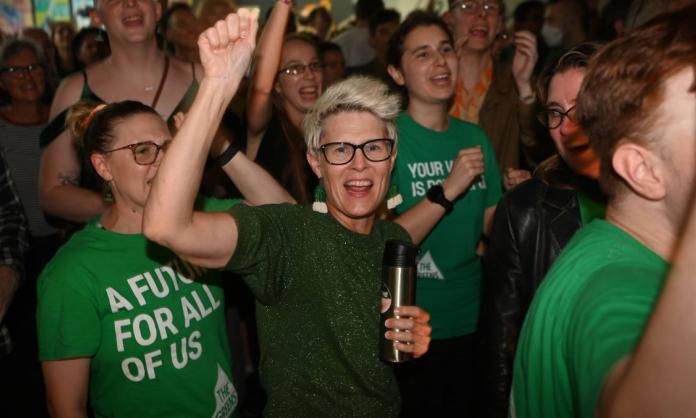The Labor Party has stumbled arse-backwards into government largely on the back of a wave of anti-Liberal sentiment, often focused on climate change. Yet climate change barely featured as a topic of discussion during the campaign. Neither the Coalition nor the Labor Party wanted to talk about it, and neither did the press gallery journalists who inhabit the same “Canberra bubble”. In these circles at least, as Ketan Joshi put it in an article for Renew Economy, “It wasn’t a ‘climate election’—it was a ‘DO NOT TALK ABOUT CLIMATE election’”.
Part of Labor’s “small target” strategy involved scaling back the already massively inadequate emissions reduction targets it took to the 2019 election, along with an attempt to compete with the Coalition over which party is more enthusiastic about building new coal mines. This may have contributed to the party holding on to mining regions such as the electorate of Hunter, where its primary vote was up 1.4 percent. But the silence on climate inside the tent of the media and political establishment wasn’t the result of a calm and temperate atmosphere outside: it was the silence experienced by those with their fingers pressed firmly into their ears.
Outside the tent, discussion of climate change was raging. The 2021 edition of the Australia Institute’s Climate of the Nation report, which has tracked Australians’ attitudes to climate change annually since 2007, found that the proportion of people saying they were “concerned” or “very concerned” about climate change had risen to an all-time high of 75 percent, and that 82 percent of people supported the phasing out of coal-fired power stations.
This should hardly come as a surprise. Since the last election in May 2019, we’ve experienced a series of climate-related disasters. First there was the 2019-20 summer bushfire catastrophe. Would people so soon forget the sight of children huddling on beaches and in boats or of cars jammed up on highways as the walls of flame approached? Would they forget the criminally casual attitude of Scott Morrison, who at the height of the fires notoriously went on holiday to Hawaii?
Then there were the devastating floods that hit southern Queensland and northern New South Wales in February and March this year. Would people forget the scenes in Lismore on the morning of 28 February—an entire town submerged under 14 metres of water and residents trapped on their roofs being rescued, not by the State Emergency Services or the army, but by a ragtag crew of locals and their fleet of dinghies? Would they forget the ten days it took before Morrison saw fit to declare a “national emergency”? Despite the “cone of silence” adhered to by the major parties and the media during the campaign, the answer is clearly no.
The big winners in the election were the so-called teal independents and the Greens. The teals picked up a swathe of seats, while the Greens have gained three in the House of Representatives from the Queensland electorates of Griffith, Ryan and Brisbane to add to the seat held by party leader Adam Bandt in Melbourne since 2010. The Greens have also likely increased their representation in the Senate from nine to twelve, which means Labor will have to gain their support for any legislation opposed by the Coalition.
Bandt calls it the “Green-slide”. Nationally, the party increased its lower house vote by 1.3 percentage points to 11.7 percent. This is significant, but not unprecedented. It’s slightly down, in fact, on the 11.8 percent gained in 2010.
The significance of the Greens vote is masked somewhat by the fact that in a number of wealthy, inner-urban seats such as Kooyong in Melbourne where the party has previously done well, many of its voters switched their allegiance to the teals. In Kooyong, for instance, the Greens’ share of the vote fell by 15.3 points to just 5.7 percent. In Goldstein, the Greens’ vote was down 6.9 points.
In electorates with no teal or other prominent independent candidates running, the Greens generally did well. The vote for party leader Adam Bandt in the seat of Melbourne was up 2.5 points to an outright majority of 50.6 percent. In the inner-urban seats of Cooper in Melbourne’s northern suburbs and Macnamara in the south, the Greens increased their vote by 6.7 and 5.2 points respectively. In the electorate of Sydney, the Greens vote was up 5 points and in neighbouring Kingsford Smith it was up 4.2 points.
The Greens’ vote was up 4.4 points in the seat of Richmond, just south of the Queensland border in one of the areas hardest hit by flooding in February and March. In the two seats the Greens won decisively in Brisbane, Griffith and Ryan, the party’s vote increased by 11 and 10 points respectively. In the electorate of Brisbane, which the Greens won more narrowly, it was up 4.4 points.
It would be easy to attribute all this purely to the floods and fires. On a national level, this was no doubt a major factor. In Melbourne at least, the most widespread slogan used by the Greens on posters in the lead-up to the election was simply “vote climate”. And it’s equally clear that the recent floods in Brisbane contributed to the party’s particularly strong performance there. But leaving it at that doesn’t really explain the scale of the shift in sentiment, particularly in Griffith and Ryan.
To understand that, we have to get down to the more granular level of the campaigns the party ran in those areas. Politicians, particularly those on the left, are apt to throw around terms like “people power” quite a bit. A lot of the time, this is just rhetoric with little connection to the drab reality of electoral campaigning in practice. But in the case of the Greens’ campaign in Griffith at least, it seems to apply. Some key numbers indicate the scale of it. According to Greens’ councillor for the Gabba Jonathan Sri, more volunteers “than Labor and the Liberals combined” and 90,000 doors knocked resulted in more than 30,000 conversations with voters.
It wasn’t just the scale of the campaign that mattered. It was the message being delivered, and the fact that, in Griffith at least, this message was backed up by a visible Greens presence in the community—not just in the immediate lead-up to the election, but for months and years before.
The Greens’ platform for this election was more left wing and “social democratic” than those it has run on in previous elections. At its centre was a promise to “tax the billionaires and big corporations, and provide the things we all need for a better life”. Talking points included things like “The Greens will make Clive Palmer pay more tax so you can fix your teeth”. Party leader Adam Bandt consistently railed against “big corporations and billionaires” and the fact that “Liberal and Labor have designed a system which gives [them] too much power, increases the cost of everything and pushes down wages”.
No doubt the emphasis varied depending on the electorate and/or the candidate, but overall, this was a Greens campaign quite different to those run under previous leader Richard Di Natale, when the party was more oriented to winning over Liberal voters in wealthy electorates that swung hard to the teals this time.
Under Bandt, the party has refocused its attention on its inner-city heartlands. In more traditionally left-wing electorates like Griffith, which, although rapidly gentrifying, have a high concentration of young people (Griffith, Ryan, Brisbane and Melbourne make up four of the five youngest in the country) and renters, and pockets of real poverty, there’s more of a space for the kind of “left populist” talk about taxing the billionaires, capping rents, calling landlords (as Jonathan Sri recently did) “bludgers who hoard properties” and so on than there is on Sydney’s north shore or in Melbourne’s wealthy eastern suburbs.
The Greens’ platform clearly resonated in these areas. In Griffith, however (and to a somewhat lesser degree Ryan), this resonance was enhanced by the party’s more activist approach. It’s one thing to show up at someone’s door talking about how you’re going to tax the billionaires to pay for dental care, put a cap on rents, build more public housing, make education free or do something about aircraft noise. But when you can combine that, as the Greens did in Griffith, with a conspicuous presence in the community over the months and years leading up to the election, it makes it more likely you’ll be taken seriously.
This long-term presence is reflected in the gradual build-up of Greens support and representation in these areas over the past decade. In Griffith, the party’s primary vote has risen from 10 percent in 2013 to well over 30 percent, and it’s a similar picture in Ryan and Brisbane. Jonathan Sri was elected to Brisbane City Council in 2016. Amy MacMahon was elected to state parliament as MP for South Brisbane in 2020. Sri in particular has used his high-profile platform effectively to promote a range of activist initiatives in the community—something that has largely been absent from the Greens’ approach to politics and political representation in local and state governments elsewhere in the country.
So while there’s no doubt that the Greens in Brisbane went into the election with a favourable set of circumstances for their campaign, it was the campaign itself, and the work done in the months and years preceding it, that super-charged their vote and delivered a historic breakthrough for the party.
All this should provide encouragement to everyone fighting for a better world. For decades, we’ve been told by Labor, and often Greens members as well, that we need to “be realistic” in our demands. But the Brisbane “Green-slide” shows we need not be constrained by the straitjacket that the major parties and the mainstream media put on politics. The Greens, of course, are far from being an anti-capitalist party. But the fact that they ran with a more left-wing platform and some at times quite radical sounding “left populist” rhetoric and won shows the potential—in the right circumstances—for socialists to make our own electoral breakthrough.
What the Greens do with their increased representation in parliament is another question. Whether they attempt to build on the more leftward jag that brought them success in this election or follow the pattern set by, for example, their counterparts in the German Greens—of shifting further to the centre in proportion to the extent of their power within the existing system—is yet to be seen. One thing is certain, however: winning the radical change we need, whether on climate, housing, or any of the other areas the Greens campaigned on, will require much more than the kind of parliamentary “wheeling and dealing” that has been their stock in trade over the past two decades.









